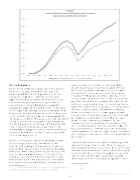135.00 130.00 125.00 120.00 115.00 110.00 105.00 Exhibit 4 Indices of Real Retail Sales and Real Retail and E-Commerce Sales Combined (2000=100); 2000-2016 100.00 2000 2001 2002 2003 2004 2005 2006 2007 2008 2009 2010 2011 2012 2013 2014 2015 Index of Total Real Retail and E-comm Index of Real Retail Online Shoppers Much of the difference observed in the growth trends for on-ground and online retail can be explained by the demographics of online shoppers. In general, members of younger age cohorts tend to spend more of their time and money shopping and buying online, but consumers in the middle age demographic categories, ages 35-44 and 45-54, constitute a much higher percentage of online shoppers than they do of the overall population. According to a study by Business Intelligence, people aged 35- 44 make up 17.9% of the population, yet represent 23.3% of the online shoppers. The numbers for the 45-54 year-old cohort are 19.7% and 24.0%. This is important because consumers in the middle aged categories tend to have much more money to spend than those in the younger and often older age cohorts. While studies show that most shoppers prefer to buy things in a store, the advent of the internet has changed the way almost everyone approaches the business of shopping. Roughly 80% of all Americans now shop online, and 15% buy online on a weekly basis.32 In an economy where price is becoming more important than ever before, as will be discussed further below, the internet has enabled almost instantaneous 3 Smith, Aaron and Monica Anderson, Online Shopping and E-commerce, Pew Research Center, December 19, 2016 opportunities to compare prices regardless of where a shopper might be located. Almost half of all shoppers now search and compare prices online, and many will even do so while in a store.43 Shoppers will often identify an item for purchase, take a look at it in an actual store, and then make the purchase at the lower of the online or on-ground prices. Consumers will also seek information from a variety of online product reviews, most of which have been offered by other consumers, prior to making a purchase. Consumers indicate that they are most affected by negative as opposed to favorable reviews. What is most interesting, however, is that frequent online shoppers tend to prefer online to in-store shopping, yet they are more likely to buy online without comparing prices, enabling online retailers to directly target those customers with higher-priced items in their online marketing activities. 54 These combined factors have forced on-ground retailers to lower their prices, thus narrowing margins and making it even more difficult to cover the overhead expenses of the physical store and product distribution. Even though an on-ground retailer may sell the same quantity of goods, revenue growth will slow as price growth slows. 4 Ibid. 5 Ibid. 4 ©2017 Credit Research Foundation
